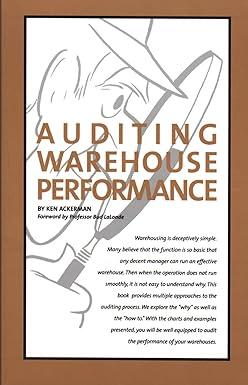Question
1. For the company that does not have resource limitation, in what sequence would following budgets be prepared? i. cash budget ii. sales budget iii.
1. For the company that does not have resource limitation, in what sequence would following budgets be prepared?
i. cash budget
ii. sales budget
iii. inventory budget
iv. production budget
v. purchases budget
a. sequence ii, iii, iv, v and i. c. sequence ii, iv, iii, v, and i.
b. sequence ii, iii, iv, I and v. d. sequence iv, iii, ii, I, and v. (rpcpa)
2.) Budgets that are prepared for various degrees of plant operations and are used to control costs at different levels of productive capacity is: (rpcpa)
a. Operating budgets. c. Rolling budgets.
b. Flexible budgets. d. Out-of-pocket costs.
3. Feedback, feedforward, and preventive are important types of control systems and procedures for accounting information system. Which of the following is in the correct order of feedback, feedforward, and preventive control system? (cma)
a. Cost accounting variances, separation of duties, and cash planning.
b. Cash budgeting, capital budgeting, and hiring qualified employees.
c. Inventory control, capital budgeting, and cash budgeting.
Cost accounting variances, cash budgeting, and organizational independence
4.) Which one of the following sequences for performance reports can best be used in the management control process as a communications tool?
a. Plan approval, feedforward, feedback, corrective action
b. Feedforward, plan approval, feedback corrective action
c. Plan approval, feedforward, corrective action, feedback
d. Feedforward, plan approval, corrective action, feedback
5.) Which one of the following is not considered to be a benefit of participative budgeting?
a. The budget estimates are prepared by those in direct contact with various activities.
b. Individuals at all organizational levels are recognized as being part of the team; this results in greater support of the organization.
c. Managers are held responsible for reaching their goals, and they cannot shift their responsibility by blaming the unrealistic goals demanded by the budget.
d. When managers set the final targets for the budget, top management need not be concerned with the overall profitability of current operations. (cma)
6.) Budgetary slack can best be described as (cma)
a. The planned overestimation of budgeted expenses.
b. A plug number used to achieve a preset level of operating income.
c. The elimination of certain expenses to enhance budgeted income.
d. The planned underestimation of budgeted expenses.
7. When a flexible budget is used, an increase in production levels within a relevance range would
- Change total fixed costs.
- Not change fixed costs per unit.
- Not change variable costs per unit.
- Not change total variable costs.
Answer the following and explain!
Step by Step Solution
There are 3 Steps involved in it
Step: 1

Get Instant Access to Expert-Tailored Solutions
See step-by-step solutions with expert insights and AI powered tools for academic success
Step: 2

Step: 3

Ace Your Homework with AI
Get the answers you need in no time with our AI-driven, step-by-step assistance
Get Started


